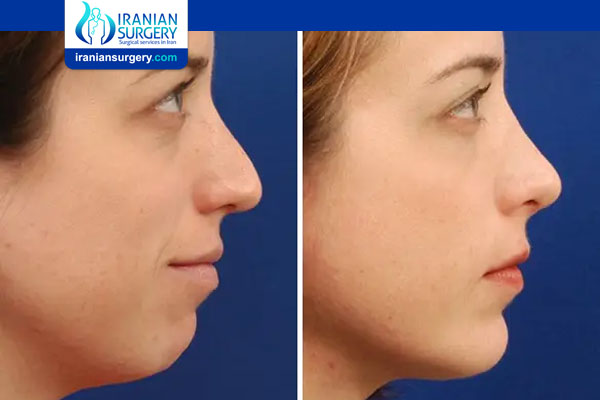Chin Implant Risks
Chin Implant Risks and Complications
Like any plastic surgery, there are some risks associated with a chin implant. The decision to have chin surgery is extremely personal. You'll have to decide if the benefits will achieve your goals and if the risks and potential complications of chin surgery are acceptable. Keep on reading and you will find out more about the potential risks involved with chin implants, whether there are any long-term concerns and are there any risks if you decided to remove them.
The Possible Risks of Chin Surgery Include, But Are Not Limited To:
Malposition
Implant malposition is a serious complication of chin augmentation. It occurs when the “pocket” formed by the surgeon to hold the implant in place is either too large or too small, causing the implant to sit unevenly and appear visibly crooked. To resolve this issue, your surgeon will need to revise the procedure, create a new pocket and re-insert your implant.
Read more about : jawline and chin contouring with non-surgical dermal fillers
Mental Nerve Damage
The mental nerve is responsible for supplying sensation to the chin, lower lip and certain teeth. It can be damaged, bruised, stretched or even severed during a chin augmentation, causing altered sensation in the area. Your surgeon will need to place the implant with care and ensure that the nerve is protected at all times to prevent this complication.
Infection
Whenever you undergo plastic surgery, there is a chance of an infection. Several factors increase your risk of an infection during chin augmentation, including intraoral placement, which is why your doctor might prefer an external approach. In addition, they will place you on antibiotics before, during and after the procedure to keep infections at bay.
Read more about : Lip augmentation
Bone resorption
Resorption occurs when the bone beneath your implant wears, ultimately causing asymmetry. It tends to develop when the surgeon places the implant too high on the chin bone and/or doesn’t secure it properly. To prevent resorption, your doctor will make sure the implant is properly inserted and secured along the lower edge of the chin bone.
Extrusion
Extrusion develops when your implant shifts after surgery. It can be avoided by positioning the implant properly at the inferior border of the mandible and securing it. Once extrusion occurs, it can be a recurring issue and a revision procedure will be necessary.
Unsightly Or Retracted Scar
When your chin augmentation is performed properly, your scar should be virtually invisible. If your surgeon doesn’t close the incision carefully, you run the risk of an unsightly or retracted scar that is highly visible to the eye. To ensure a discreet outcome, you doctor will meticulously close each incision in layers.
Muscle Dysfunction
A major complication of chin augmentation is muscle dysfunction, which presents as a dent in the area. It occurs due to an injury of the muscle during the insertion of the implant. Fortunately, most patients can prevent permanent damage by removing the implant early and undergoing a revision procedure.
Chin Implant Removal Risks
The most common chin implant removal concerns are that of developing a soft tissue droop or witch's chin. The best way to avoid that concern is to do a simultaneous mentalis muscle resuspension/tightening as a preventative measure. Depending upon the point of insertion and size of the chin implant will determine if this may be warranted or not.
Read more about : Pain After Jaw Fillers
Read more about : Jaw Fillers Men
Chin Implant Complications Years Later
Properly placed implants do not shift without major trauma. A firm capsule develops around them and securely holds them in place after a few weeks. Most miss-placed implants are put in wrong and this is often not noticed until after the swelling from the operation has subsided. Also, if too big a pocket was made so as to get the implant in very easily there is more chance of shifting before a pocket develops. An experienced surgeon will make a pocket that is only slightly larger than the implant being placed. A good quality Silicone implant purchased from Implantech or any other reputable company will last a lifetime without any complications.
Minimizing Risks Associated with Chin Implant Surgery
Although risks associated with surgery can be prevented by making sure you choose the right surgeon and following your doctor’s recommended post-procedure protocol, it is still good to be aware of the issues that may arise. If you are serious about getting a chin implant, it is important to discuss with your surgeon, which approach is going to be used to insert the implant.
Generally, there are two ways to place a chin implant. They can be inserted through a small curved incision under the chin or through the mouth by cutting the chin muscle to allow for enough space for the implant placement. In some cases, this may cause the chin muscle to sag later in life. This condition, called ptosis, may also cause the implant to shift into the groove inside of the mouth. Find out from your surgeon which approach would be best for your facial structure and opt for the less invasive way.
In some cases, getting a chin implant from an inexperienced surgeon can increase the risk of nerve damage that may lead to permanent loss of lower lip sensation or movement. Although rare, this is something to consider when searching for the right surgeon to perform the procedure on you. The risk of infection is present with any surgical procedure; however, this can often be treated with antibiotics. Lastly, implants can begin to show some resorption to the bottom jaw bone over time, but this is usually not a serious problem and is usually only visible through an x-ray. Risks can vary greatly from person to person, which is why it is crucial to do your due diligence in finding an experienced facial plastic surgeon
Source:
https://www.radyrahban.com/procedures/face/chin/risk-and-complications/
https://www.realself.com/question/what-risks-associated-chin-implants


